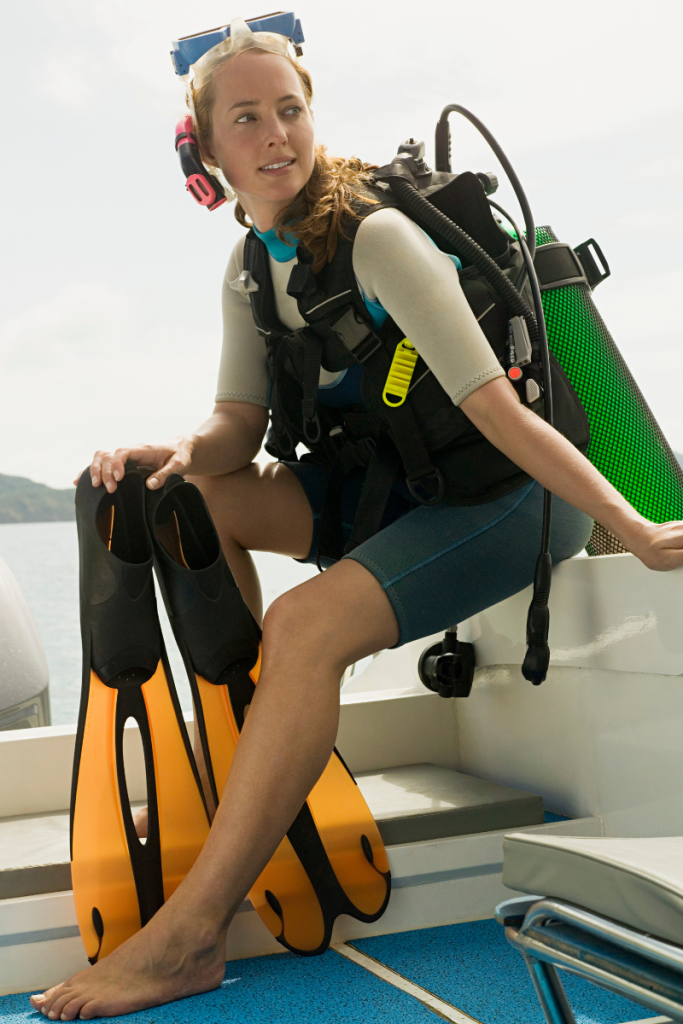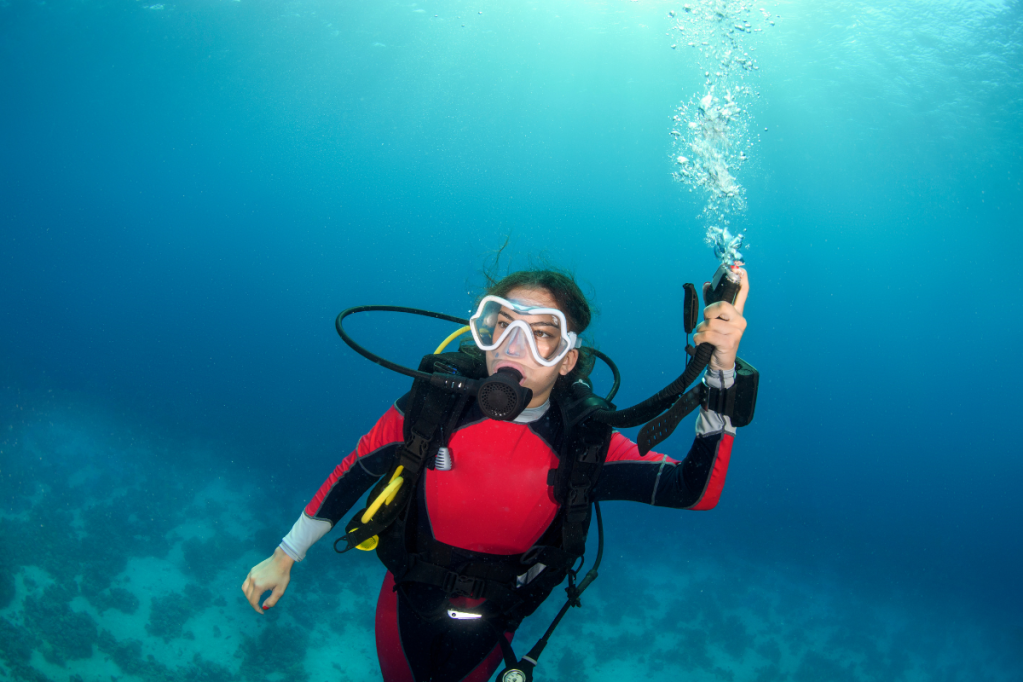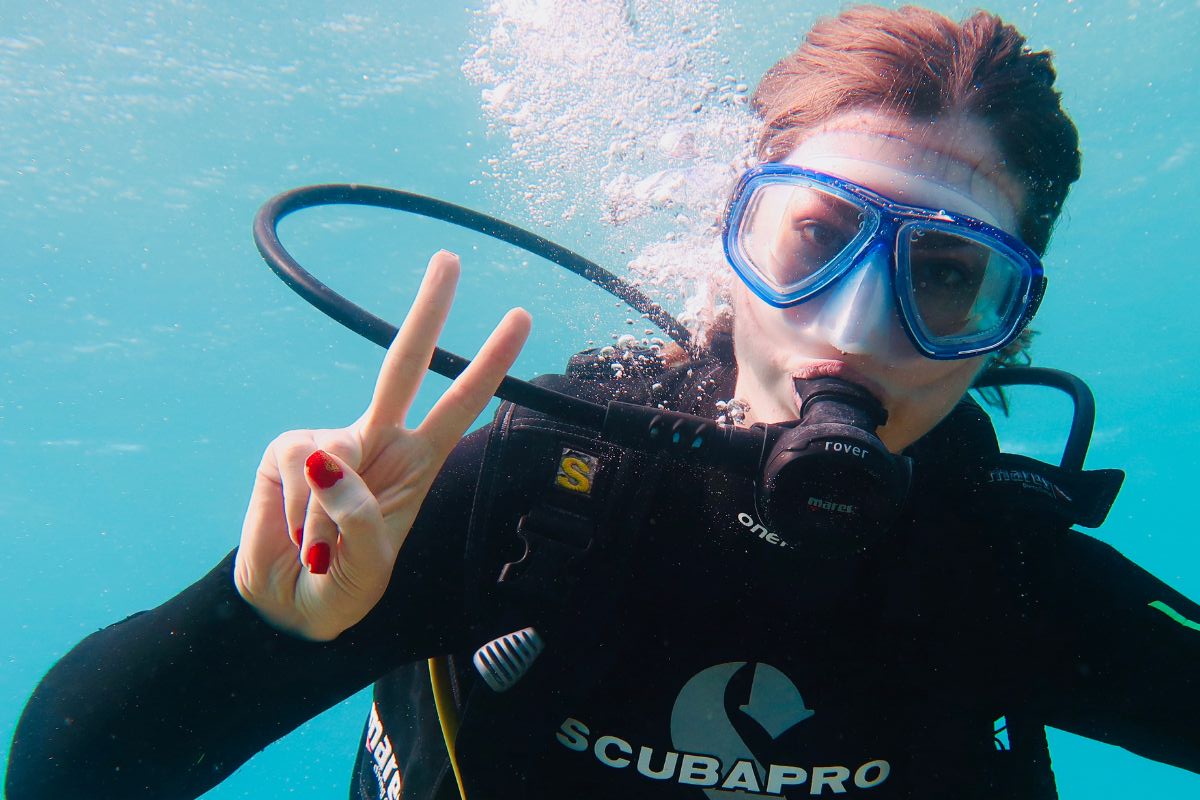As a Scuba Woman, reviewing your dive training and practicing dive skills will build more confidence and make you a confident scuba diver. I am a PADI-trained Senior Scuba Woman, and below, I revise B.W.R.A.F. – PADI’s acronym to remember what to do when completing a Buddy Check. I also look at the PADI acronyms S.O.R.T.E.D. and S.T.A.R.S. to help Scuba Women achieve a controlled 5-point descent and 5-point ascent.
It’s never too late to become a Confident Scuba Woman and have exhilarating diving adventures in exotic marine environments. Take the dive with me – Tanya.
B.W.R.A.F. Buddy Checks for Confident Scuba Women
Buddy Checks are designed for divers to catch any potential problems before diving. Buddy Checks ensure a scuba diver and their buddy have geared up correctly, and everything is in working order. A Buddy Check familiarizes you with each other’s dive gear, including alternate air sources and releases. Whether you regularly dive with your buddy or are allocated one on a dive trip, Buddy Checks are a must, designed to keep scuba divers safe. My Buddy Check is a natural part of my dive, something I never skip.
I still follow my open water PADI training and use the acronym B.W.R.A.F. or my version Big Whales Rule All Fish.
B – BUOYANCY/BCD. Fully inflate your buoyancy compensator, and check that the pressure release valve works. Deflate and ensure all deflating/dump valves are working. Familiarize yourself with your buddy’s low-pressure inflator hose and its buttons, as each BCD varies. Secure your waist and chest straps and once confident everything is in working order, inflate your B.C.D. and be ready to enter the water. Ensure toggles for your dump valves aren’t caught under a strap or entangled.
W—WEIGHTS are on and secure. Know the releases and ensure they are fully secured. Remember the right-hand release for weight belts in an emergency. Weights should be evenly distributed, and the end of the belt should be tucked away neatly.
Integrated weights are clipped in securely and evenly distributed. Listen for the click to know the weight pockets are secure. It is an expensive lesson to learn if you lose a weight pocket – trust me, I know!

R – RELEASES—Know where all quick-release straps are in case of an emergency, and ensure straps aren’t twisted, clips are done up, and straps are secure. Integrated weights can be tricky, so check your buddy and know how to release theirs. Secure any extra equipment and tuck away anything that is dangling. I tuck my air gauge under the waist strap of my B.C.D., so I always know where it is. Check that the tank strap is nice and tight.
A – AIR SOURCE – air is turned on; check that your tank is at 200 bar (3000 PSI) or more and the air tastes fresh. Take at least three breaths through your regulator and octopus and watch the air gauge as you breathe; the needle must stay steady. As per D.A.N.’s guidelines, your cylinder valve should be fully open. It can be confusing as many divers do a quarter-turn back. Originally designed to protect valves from leaking, with improved valve design, it is no longer necessary to do the quarter turn. The best practice is to leave your cylinder valve open to prevent diving accidents at depth. I have included a link to an article by Chloe Strauss from D.A.N. (Divers Alert Network) See Old Habits Die Hard

F—FINAL CHECK and fins/mask. Have you defogged your mask? Are you comfortable? Is the tank too high or low? Does anything feel lopsided? Mask on? Fins on? Little things can catch you; take your time and double-check. Where’s your dive computer? After a frantic search, I found mine in my wetsuit pocket.
Confident Scuba Women Dive Skills – A 5-point descent S.O.R.T.E.D
As a beginner diver, there is a lot to remember. I find the Padi acronyms a great way to stay focused on the steps that need to be completed. A free descent can be tricky; I floated just a few centimeters under the surface on one of my first descents, blissfully unaware I wasn’t descending. To descend confidently, remain vertical, fins pointing down, legs slightly bent to lessen water resistance, deflate your B.C.D. and exhale. Don’t waste air and energy trying to swim down to the dive site. Relax and slowly sink on the exhale.
A 5-point descent will get a scuba diver to the dive site effortlessly while conserving air. Remembering the acronym S.O.R.T.E.D. will help you perfect your descent.
S—SIGNAL—Gather with your buddy and signal you are ready to begin your descent by making a fist and pointing your thumb down. Ensure your buddy signals OK in return.
O – ORIENTATION – Orient yourself by looking at your surroundings and noting any fixed landmarks. Check your compass headings and finally look down into the water, ensuring you have a clear path for your descent and know where you are about to dive.
R – REGULATOR – Switch from your snorkel to your regulator. Something I have missed on more than one occasion, generally when a group of us are going down a mooring line, and I’m at the back, conserving air with my snorkel in! It never takes me long to realize my mistake and switch to my regulator!
T – TIME – Look at the time, though now our dive computers display the time and the length of our dives.

E – EQUALIZE/ELEVATE – Elevate your low-pressure inflator hose and equalize your ears.
D – DEFLATE – Release air from your B.C.D. by pressing the deflate button on your low-pressure inflator hose, exhale, and begin your controlled descent. As you descend, remember to equalize your ears and check your buoyancy, becoming neutrally buoyant as you approach the dive site.
Controlling your breath helps your descent. Count your breath as you inhale, and then double the time as you exhale. Breathe in for a count of four, and breathe out for a count of eight. On the exhale, you will descend in the water column. There is no need to expend energy trying to swim down to the dive site. Relax and let your breath do the work for you.
Confident Scuba Women – A 5-point ascent S.T.A.R.S.
Ascending slowly and correctly is imperative to a diver’s safety. To gain confidence, we again look to a PADI acronym – this time S.T.A.R.S.
On land, we expel nitrogen from our bodies through our skin and as we breathe. When scuba diving and breathing compressed air under water pressure, nitrogen is absorbed into our blood and tissues. The nitrogen in our bodies is not a problem while we remain under pressure. However, as scuba divers begin to ascend and the water pressure decreases, nitrogen is released from tissues into our bloodstream. If a scuba diver ascends too quickly, the nitrogen forms bubbles in our tissues and blood, causing Decompression Sickness (D.C.S.), more commonly known as the bends. D.C.S. can be fatal but avoided by ascending at the correct rate.
S – SIGNAL – Gather with your buddy and signal you are ready to begin your ascent by making a fist and pointing your thumb up. Ensure your buddy signals OK in return.
T – TIME – Time and perform your safety stop as directed by your dive computer. If you have exceeded your No-Decompression limit, perform decompression stops as guided by your computer.

A – AIRWAY – Look upwards to ensure the ascent path is clear of obstacles (like the bottom of a boat).
R – REACH – Stretch your arm above your head to protect you from unseen objects.
S – SWIM – Swim slowly to the surface. Hold your inflator hose to release air from your B.C.D. (Buoyancy Control Device) as it expands under less water pressure. Complete your Safety Stop. Do Not inflate your B.C.D. until you are safely on the surface. Once on the surface, signal you are okay by placing your hand on your head.
How to know what a safe ascent rate is?
Always dive with a computer and let it guide your ascent rate. To be safe, do not ascend more than 9m(30ft) per minute, follow your smallest bubbles, and perform a minimum 3-minute safety stop at 5 meters.
IT’S NEVER TOO LATE – TAKE THE DIVE WITH ME, TANYA – HELPING WOMEN DIVE CONFIDENTLY
Want to be part of our powerful community? Subscribe to receive the latest posts straight to your inbox and join other women scuba diving with confidence 🐟🐟🐟
If you liked this post or any other, please feel free to share using the buttons below.


2 thoughts on “Confident Female Scuba Divers BWRAF, 5-Point Descent, and Ascent”